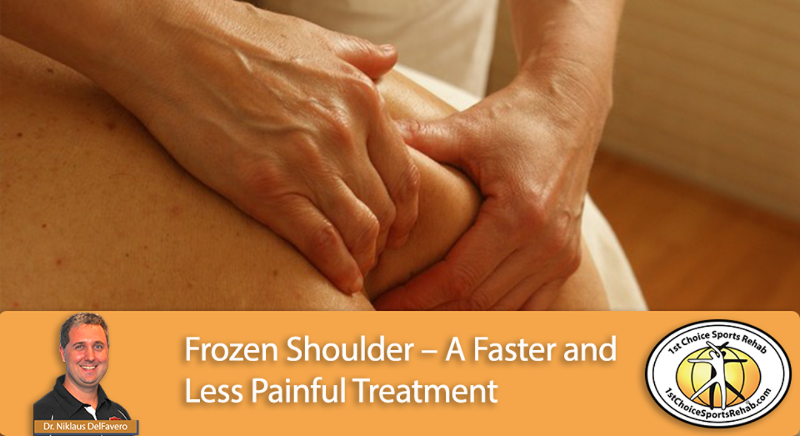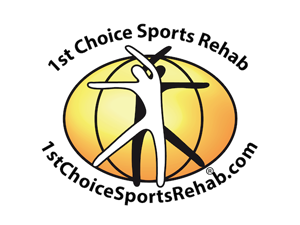Frozen Shoulder – A Faster and Less Painful Treatment

One of the conditions patients often ask us about is frozen shoulder. Because it can be very painful and disabling to the patient, most doctors and therapists would agree that frozen shoulder is one of the most challenging injuries to treat.
For the past few years I have invested considerable time integrating what I learned from research with my experience treating peripheral nerve entrapments and fascial restrictions. My goal was to develop a new approach that would increase the success rate, shorten the recovery time and also make the treatment more comfortable for the patient.
This article will briefly explain what it is, and some of the treatment options available.
Introduction to Frozen Shoulder
 Frozen shoulder is the common name for a condition called Adhesive Capsulitis. The injury involves the fibrous sheath (the capsule) that surrounds the glenohumeral joint (ball and socket joint) of the shoulder. This capsule surrounds the joint and contains the liquid (synovial fluid) that lubricates the joint and maintains joint health. Under normal conditions, the capsule stays relaxed during everyday movements and only tightens to stabilize the joint at the extreme end of shoulder movement.
Frozen shoulder is the common name for a condition called Adhesive Capsulitis. The injury involves the fibrous sheath (the capsule) that surrounds the glenohumeral joint (ball and socket joint) of the shoulder. This capsule surrounds the joint and contains the liquid (synovial fluid) that lubricates the joint and maintains joint health. Under normal conditions, the capsule stays relaxed during everyday movements and only tightens to stabilize the joint at the extreme end of shoulder movement.
Adhesive capsulitis occurs when this capsule spontaneously contracts. Patients feel a stiffness in the joint that progressively worsens to the point where they cannot move their arm more than a few degrees in any direction. At its worst, there may be extreme pain associated with any movement of the joint. Patients often sleep in a chair or on a couch to avoid the added pressure of their body weight on the joint when in bed.
Women, diabetics, and those with post-chest cavity surgeries (such as heart surgery) are at higher risk of developing frozen shoulder. Studies report that most cases of adhesive capsulitis will resolve within a two year period. The definition of “resolved” indicates lack of pain; however, many chronic frozen shoulder cases continue to severely limit shoulder mobility long after the pain has resolved.
Treatment of Frozen Shoulder
There are many treatment protocols, but some of the most popular methods are described below.
Most treatments will start by heating up the capsule with moist heat and/or continuous ultrasound. Continuous ultrasound has been shown to help soften the collagen within the capsule, making manual therapy treatments more comfortable.
After the tissue is heated up, mobility exercises are performed. One popular exercise called Codman’s circles can be performed for a few minutes to try and help mobilize and lubricate the joint. This involves putting a weight such as a 5 lb. ankle weight around the wrist. The patient bends forward trying to let the weight distract the shoulder joint while they slowly and lightly swing the arm in multiple directions.
Next, clinicians typically have the patient perform a series of shoulder joint mobilization exercises involving pulleys or a stick. Treatment of this sort is often painful and may take many months to complete.
If results with these conservative measures are unsuccessful, more invasive treatments may follow such as cortisone injections, hydrodilation, or manipulation under anesthesia.
Cortisone injections are a great complement to manual therapy techniques, since they allow the practitioner to mobilize the shoulder with much less pain.
Manipulation under anesthesia is a procedure where the patient is put under anesthesia and an orthopedist will mobilize the shoulder to physically break up the adhesions.
Hydrodialation is slightly less invasive and involves injection of a saline solution into the joint. This increases pressure within the capsule with the hope that the sustained pressure will help break down the adhesions within the capsule.
All of these procedures have mixed success rates. It is not uncommon for patients to show a temporary increase in flexibility, but within a few weeks the shoulder capsule may tighten back up.
A More Effective & Less Painful Approach
 In our clinic, we observed that by treating the nerve entrapments as well as fascial restrictions prior to any direct mobilization of the capsule, it was possible to reduce pain in a very short period of time. Patients frequently mention that they are able to sleep through the night in their beds in as little as 1 to 2 visits. Restoring full range of motion in the shoulder joint still presents a challenge, but our approach requires fewer treatments, and patients report these treatments are much more tolerable than other methods.
In our clinic, we observed that by treating the nerve entrapments as well as fascial restrictions prior to any direct mobilization of the capsule, it was possible to reduce pain in a very short period of time. Patients frequently mention that they are able to sleep through the night in their beds in as little as 1 to 2 visits. Restoring full range of motion in the shoulder joint still presents a challenge, but our approach requires fewer treatments, and patients report these treatments are much more tolerable than other methods.
We at 1st Choice Sports Rehab are constantly looking for more effective treatment protocols and are confident that we will continue to find ways to speed up the recovery time for this debilitating injury.
As a swimming coach and former swimmer myself, I have a special interest in these injuries. I would love to hear from you or someone you know who is suffering from frozen shoulder.
Dr. Niklaus DelFavero, the owner of 1st Choice Sports Rehab Center, is a former collegiate and internationally competitive swimmer. He enjoys helping athletes overcome the injuries that can occur when striving for ever higher levels of performance. There are two office locations: Decatur and Johns Creek. To schedule an evaluation for either office, simply call 404-377-0011. If you have other questions or concerns, you may click here to email Dr. DelFavero directly.
2545 Lawrenceville Hwy
Suite 100
Decatur, GA 30033
404-377-0011
fax 770-939-9353
9810-B Medlock Bridge Rd
Suite 104
Johns Creek, GA 30097
404-300-9931
fax 770-939-9353
